Ethernet Cables Explained: categories, types, CAT 5, 5e, 6, 6a, 7, 8
Understand the different types of Ethernet cables, their pinouts, and how to use them for your network: Cat 5, 5e, and Cat 6, 6a, 7, 8.
Ethernet IEEE 802.3 Includes:
Ethernet introduction
Standards
Ethernet data frame structure
100Mbps Fast Ethernet
Gigabit Ethernet, 1GE
10 Gigabit Ethernet, 10GE
Single Pair Ethernet, SPE
Ethernet cables
How to buy Ethernet cables
How long can an Ethernet cable be
Routers, hubs, switches - the differences
Ethernet switch
How to buy best Ethernet switch
Ethernet industrial switch
Power over Ethernet, PoE
Ethernet splitter
Carrier Ethernet
Ethernet Products Shopping Page
There are many Ethernet cables that can be seen and used. Understanding the different types along with their performance specifications and sometimes their pin-outs or pin connections can help ensure that the right cables are used inth e right place and with the correct connections.
Often Ethernet cables are supplied free with equipment that uses Ethernet connectivity or they may be bought separately.
Understanding these cables helps ensure that the best performance can be obtained and many issues can be resolved.
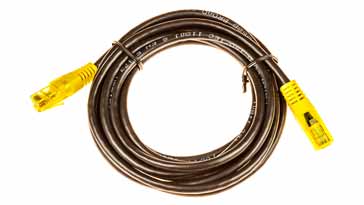
There are several different varieties and categories of Ethernet cable that can be obtained: speed variations, crossover cables, Cat 5, Cat 5e, Cat6, Cat 6a, Cat 7etc..
Normally Ethernet cables will be bought and there is no major need to understand what is inside or on the connectors, although it can be both interesting and helpful on some occasions. Even so, an understanding of the different types of Ethernet cable and the maximum lengths that should be used is helpful.
The commonly used network cables: Cat 5, Cat 5e, Cat 6, Cat 6a, Cat7 all have different levels of performance, and therefore to is necessary to buy or select the right cable for the right application.
These network cables are used for connecting a variety of network elements from Ethernet switches and Ethernet routers to computers, servers and other network items - if there is an Ethernet interface, they can be connected using Ethernet cables.
In fact Ethernet cables of all types form the backbone of virtually all local area networks regardless of the network topology used, and as such they are of immense importance and interest.
Ethernet cable basics
The Ethernet cables for connectivity in most office and home local area networks rely on twisted wire pairs within an overall cable - Cat 5, Cat 6 and Cat 7 all used this format.
Twisting the wires together enables the currents to balance, i.e in one wire the current is moving in one direction, and in the other wire of the pair the current is going in the other, enabling the overall fields around the twisted pair to cancel.
In this way, data can be transmitted over considerable lengths without the need for undue precautions.
As several twisted pairs are contained within a particular data network cable, the number of twisted per unit length is arranged to be different for each pair - the rate being based on prime numbers so that no two twists ever align. This reduces crosstalk within the cable.
The Ethernet cables are available in a variety of lengths as patch cables, or the cable itself is available for incorporating into systems, buildings, etc. The terminations can then be made to the required connector using a crimp tool. These network cables are available in a variety of lengths - long Ethernet cables are available, some of the longest being up to 75 metres.
Earlier network cables were unshielded, but later ones were shielded to improve the performance. For example an unshielded twisted pair, UTP, cable may be satisfactory for a short run between a computer and router, but a foil shielded cable, FTP, is best longer runs or where the cable passes through areas of high electrical noise.
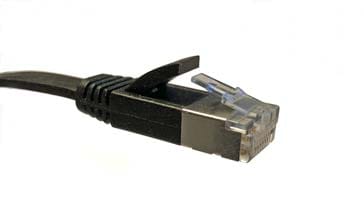
There are different methods that can be used for shielding Ethernet cables. The most common is to place a shield around each twisted pair. This not only provides shielding for the cable externally, but also reduces crosstalk between the internal twisted pairs as well.
Manufacturers can further enhance the performance by placing shielding around all the wires in the cable just under the cable sheath. There are different codes used to indicate the differs types of shielding:
- U/UTP - Unshielded cable, unshielded twisted pairs
- F/UTP - Foil shielded cable, unshielded twisted pairs
- U/FTP - Unshielded cable, foil shielded twisted pairs
- S/FTP - braided shielded cable, foil shielded twisted pairs
Where: TP = twisted pair, U = unshielded, F = foil shielded, S = braided shielding.
A further difference within the Ethernet cables whether Cat 5, Cat 5e, Cat 6, Cat 6e, or Cat 7 can be whether solid or stranded wires are used within the cable. As the description implies, a solid cable uses a single piece of copper for the electrical conductor within each wire of the cable whilst stranded wire uses a series of copper strands twisted together.
Although when buying a patch cable, it may not be necessary to know this, when installing a long cable run it may be important as each type is slightly more suitable for different applications.
Stranded cable: This type of wire is more flexible and it is more applicable for Ethernet cables where the cable may be moved - often it is idea for patch leads at desks or general connections to PCs, etc where some movement may be needed and expected.
Solid cable: Solid cable is not as flexible as the stranded type, but it is also more durable. This makes it best for use in permanent installations like cable installations under floors, embedded in walls and the like.
Categories for Ethernet cables
A variety of different cables are available for Ethernet and other telecommunications and networking applications. These network cables that are described by their different Ethernet cable categories, e.g. Cat 5 cables, Cat 6 cables, Cat 7 and Cat 8etc, which are often recognised by the TIA (telecommunications Industries Association) and they are summarised below:
Categories 1 to 4 are no longer current, but are included for completeness. Cat 5 is also virtually obsolete and it is not advisable to use it unless absolutely necessary.
Cat 1: This is not recognised by the TIA/EIA. It is the form of wiring that is used for standard telephone (POTS) wiring, or for ISDN.
Cat 2: This is not recognised by theTIA/EIA. It was the form of wiring that was used for 4Mbit/s token ring networks.
Cat 3: This cable is defined in TIA/EIA-568-B. It is used for data networks employing frequencies up to 16 MHz. It was popular for use with 10 Mbps Ethernet networks (100Base-T), but has now been superseded by Cat-5 cable.
Cat 4: This cable is not recognised by the TIA/EIA. However it can be used for networks carrying frequencies up to 20 MHz. It was often used on 16Mbps token ring networks.
Cat 5: This is not recognised by the TIA/EIA. This is the network cable that is widely used for 100Base-T and 1000Base-T networks as it provides performance to allow data at 100 Mbps and slightly more (125 MHz for 1000Base-T) Ethernet. The Cat 5 cable superseded the Cat 3 version and for a number of years it became the standard for Ethernet cabling. Cat 5 cable is now obsolete and therefore it is not recommended for new installations.
Cat 5 cable uses twisted pairs to prevent internal crosstalk, XT and also crosstalk to external wires, AXT.
Although not standardised, the Cat 5 cable normally uses 1.5 - 2 twists per centimetre.Cat 5e: This form of cable is recognised by the TIA/EIA and is defined in TIA/EIA-568, being last revised in 2001. It has a slightly higher frequency specification that Cat-5 cable as the performance extends up to 125 Mbps.
Cat 5e can be used for 100Base-T and 1000Base-t (Gigabit Ethernet). Cat 5e standard for Cat 5 enhanced and it is a form of Cat 5 cable manufactured to higher specifications although physically the same as Cat 5. It is tested to a higher specification to ensure it can perform at the higher data speeds. The twisted pairs within the network cables tend to have the same level of twisting as the Cat 5 cables.
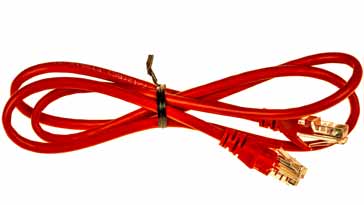
Cat 6: This cable is defined in TIA/EIA-568-B provides a significant improvement in performance over Cat5 and Cat 5e. During manufacture Cat 6 cables are more tightly wound than either Cat 5 or Cat 5e and they often have an outer foil or braided shielding.
The shielding protects the twisted pairs of wires inside the Ethernet cable, helping to prevent crosstalk and noise interference. Cat-6 cables can technically support speeds up to 10 Gbps, but can only do so for up to 55 metres - even so this makes them relatively long Ethernet cables.
The Cat 6 Ethernet cables generally have 2+ twists per cm and some may include a nylon spline to reduce crosstalk, although this is not actually required by the standard.
Cat 6a: The “a” in Cat 6a stands for “Augmented” and the standard was revised in 2008. The Cat 6a cables are able to support twice the maximum bandwidth, and are capable of maintaining higher transmission speeds over longer network cable lengths. Cat 6a cables utilise shielded which is sufficient to all but eliminate crosstalk. However this makes them less flexible than Cat 6 cable.
Cat 7: This is an informal number for ISO/IEC 11801 Class F cabling. It comprises four individually shielded pairs inside an overall shield. It is aimed at applications where transmission of frequencies up to 600 MHz is required.
Cat 8: Cat 8 cables have now been released and provide a huge step up in data rate / bandwidth. Accordingly these Cat 8 cables are generally more expensive than the older versions like Cat 6, or even Cat 7.
Further descriptions of Cat-5 and Cat-5e cables are given below as these are widely used for Ethernet networking applications today.
| Ethernet Cable Performance Summary |
|||
|---|---|---|---|
| Category | Shielding | Max Transmission Speed (at 100 metres) | Max Bandwidth |
| Cat 3 | Unshielded | 10 Mbps | 16 MHz |
| Cat 5 | Unshielded | 10/100 Mbps | 100 MHz |
| Cat 5e | Unshielded | 1000 Mbps / 1 Gbps | 100 MHz |
| Cat 6 | Shielded or Unshielded | 1000 Mbps / 1 Gbps | >250 MHz |
| Cat 6a | Shielded | 10000 Mbps / 10 Gbps | 500 MHz |
| Cat 7 | Shielded | 10000 Mbps / 10 Gbps | 600 MHz | Cat 8 | Shielded | 25 Gbps or 40Gbps * | 2000 MHz |
* 25 Gbps for Cat 8.1 and 40 Gbps for Cat 8.2.
Ethernet cable connectors
The RJ45, Registered Jack 45 connector is used almost universally as the physical connector used on Ethernet cables, and with networking cables in general.
From Ethernet Category 3 right through to Cat 6, the RJ45 is the format that is used. Cat 7 Ethernet cables can be terminated with RJ45 connectors but specialised versions called GigaGate45 (GG45) are often used. Fortunately these are backwards compatible with the RJ45 so there is no need to have a completely new installation when migrating to Cat 7.
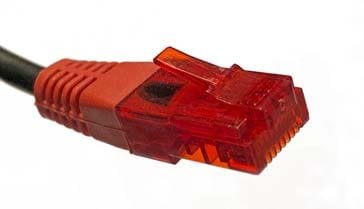
The RJ45 connector used on the ends of Ethernet cables are small plastic plugs with a retaining catch that can be released when the cable needs to be removed. The term plug refers to the male end of the connection on the network cable, and the jack refers to the port or female and normally located on the equipment.
The RJ45 connector has eight pins that are spaced around 1 mm apart, and the wires are inserted and crimped to provide a reliable connection. The actual connector type is known as an 8P8C - eight position - eight contact.
Strictly speaking the actual connector type should be reared to as an 8P8C, and the wiring pattern is RJ45, but in reality the term RJ45 for Ethernet cables is used almost universally.
Ethercon connectors
Although the RJ45 connector is ideal for most applications, it is not particularly robust. It is suitable for office, data-centre and home connections where robustness is not an issue. However there are a number of scenarios where a more robust connector is needed - applications like audio visual, stage audio and lighting, etc where Ethernet is used need a much more robust connection.
To address this problem the Ethercon connector is used. The Ethercon connector can be likened to a combination of an RJ45 with an XLR connector.
As the Ethercon connector has a circular metal outer protection combined with the RG45 style inner, it provides the required connectivity with the robustness required for applications like stage and other audio visual areas where Ethernet connections are required.
It is possible not only to obtain the Ethercon connectors on their own, but also ready made Ethercon leads as well.
Ethernet cable pinout
Although the wiring and the cable manufacture details may vary between the different cable categories, the basic connectivity remains the same. In this way Ethernet cables can be used reliably to make connections between items of equipment, etc.
A summary of the signals carried and the relevant wires and connections is given in the table below:
| RJ-45 / Cat 5 / Cat 5e Pinout & Wiring |
||||||
|---|---|---|---|---|---|---|
| Pin No |
Telephone | 10Base-T | 100Base-T | 1000Base-T | PoE Mode A |
PoE Mode B |
| 1 | +TX | +TD | +BI_DA | 48 V out | ||
| 2 | -TX | -TX | -BI_DA | 48 V out | ||
| 3 | +RX | +RX | +BI_DB | 48 V return | ||
| 4 | Ring | +BI_DC | 48 V out | |||
| 5 | Tip | -BI_DC | 48 V out | |||
| 6 | -RX | -RX | -BI_DB | 48 V return | ||
| 7 | +BI_DD | 48 V return | ||||
| 8 | -BI_DD | 48 V return | ||||
In the table, TX is transmitted data, and RX is received data. BI_Dn is bi-directional data, A, B, C, and D.
There are two standard RJ45 pinouts for the individual arrangement of the wire connections to the RJ45 connectors within an Ethernet cable: the T568A and T568B standards.
One or other of the conventions should be followed, as this will ensure the required connectivity, although as it is just a colour convention and the same wires and pairs are connected to the same pins, it does not matter which one is followed. In practice T568B is the more commonly used, and therefore it is probably best to use this one. The standard used may also be indicated on the sheath of ready made Ethernet cables.
| RJ-45 Pinout & Wiring | ||
|---|---|---|
| Pin | T568A | T568B |
| 1 | White with green stripe | White with orange stripe |
| 2 | Green | Orange |
| 3 | White with orange stripe | White with green stripe |
| 4 | Blue | Blue |
| 5 | White with blue stripe | White with blue stripe |
| 6 | Orange | Green |
| 7 | White with brown stripe | White with brown stripe |
| 8 | Brown | Brown |
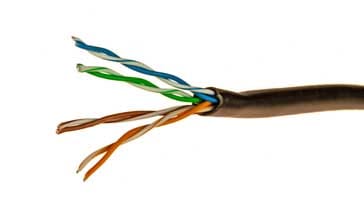
Ethernet Cat 5 crossover cables
There are a number of different configurations of cable that may be employed according to the equipment and the requirement. The most common type are the straight through cables which are wired in a 1 to 1 configuration. However Cat-5 crossover cables are also required on occasions.
Typically a Cat-5 cable used to connect a computer (PC) to a switch will be a straight through cable. However if two computers or two switches are connected together then a Cat5 crossover cable is used.
Many Ethernet interfaces in use today are able to detect the type of cable, whether it is a straight through or crossover cable, and they are able to adapt to the required format. This means that the requirement for Cat-5 crossover cables is less than it might otherwise be.
When using Cat-5 Ethernet crossover cables, they are not marked with the fact that they are crossover cables. Accordingly it is often wise to mark them to avoid confusion later.
Ethernet cable maximum lengths
Often it is necessary to use long Ethernet cables, however there are limits to the distance over which the data can be reliably carried. When long Ethernet cables are used, additional noise is picked up, and the data eventually becomes distorted by the cable.
A summary of Ethernet cables and their maximum operating lengths is given below:
| Maximum Lengths for Long Ethernet Cables | ||
|---|---|---|
| Specification | Cable type | Maximum length |
| 10BaseT | Unshielded Twisted Pair | 100 metres |
| 10Base2 | Thin coaxial cable | 180 metres |
| 10Base5 | Thick coaxial cable | 500 metres |
| 10BaseF | Fibre optic cable | 2000 metres |
| 100BaseT | Unshielded twisted pair | 100 metres |
| 100BaseTX | Unshielded twisted pair | 220 metres |
Lengths provided are those generally accepted as the maximum, but are not included in the IEEE standard.
Check out the Electronics Notes: Essential Ethernet Equipment List.
Ethernet cables infographic
I have produced a summary infographic giving details of the various Cat levels for Ethernet cables.
This will help overcome the confusion and help selecting the right cable for your situation.
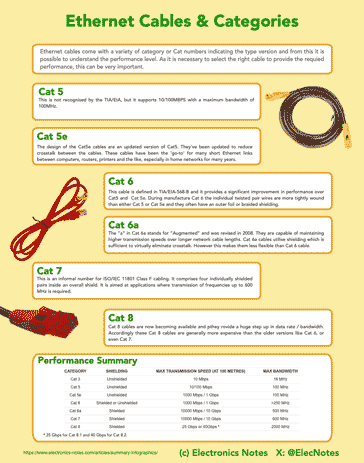
Click on image for larger version
A variety of different cables of different types and Ethernet cable categories are seen connecting different Ethernet elements together - Ethernet routers, Ethernet switches, computers, network severs, etc. Cat5, Cat5e and Cat6 are all seen. These are often within a local area network of one form or another.
The cables use the cost efficient but effective RJ45 patch connector and using this, these Ethernet cables are able to link or patch multiple items of Ethernet based equipment together.
On some occasions where specialised connectivity is needed crossover cables may be required - these sold be clearly marked as such as they may get used elsewhere unknowingly and cause the connection not to work. Apart from this, using Cat 5, Cat5e, Cat 6, Cat 7 and now Cat 8 Ethernet cables is very easy and there are normally very few issues.
 Written by Ian Poole .
Written by Ian Poole .
Experienced electronics engineer and author.
Wireless & Wired Connectivity Topics:
Mobile Communications basics
2G GSM
3G UMTS
4G LTE
5G
Wi-Fi
Bluetooth
IEEE 802.15.4
DECT cordless phones
Networking fundamentals
What is the Cloud
Ethernet
Serial data
USB
LoRa
VoIP
SDN
NFV
SD-WAN
Return to Wireless & Wired Connectivity



